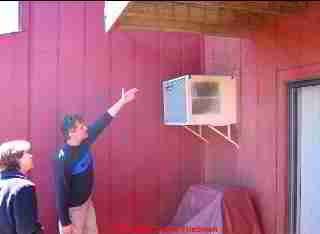 How to Prevent Mold in buildings
How to Prevent Mold in buildings
- POST a QUESTION or COMMENT about preventing toxic or other mold growth & contamination in buildings
How to prevent bulding mold contamination:
This document which explains how to prevent mold contamination or mold growth in buildings, is a section of our Mold Action Plan which provides an easy to understand step-by-step guide for dealing with toxic or allergenic indoor mold and other indoor contaminants: what to do about mold.
The steps in this document and its accompanying articles will be sufficient for many building owners who want to do their own mold investigation, mold testing, mold cleanup, and mold prevention in their home or office. Extensive, technically detailed in-depth articles are also organized at our Mold Information Center.
InspectAPedia tolerates no conflicts of interest. We have no relationship with advertisers, products, or services discussed at this website.
- Daniel Friedman, Publisher/Editor/Author - See WHO ARE WE?
How to Prevent Building Mold Contamination, Correct the Causes of Mold and Prevent Indoor Mold or other indoor environment problems
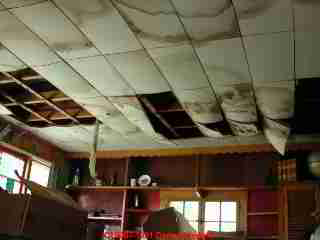 There is no point in "cleaning up" or "removing" mold if the underlying causes of a mold problem are not also addressed.
Unless the causes, such as leaks or high moisture are corrected, mold will simply recur. Band-Aid approaches like trying to
"kill" or "prevent" mold by using chemical sprays, coatings, or air cleaners are insufficient and ineffective at preventing
future mold and in some cases (such as ozone) these approaches create their own
hazards.
There is no point in "cleaning up" or "removing" mold if the underlying causes of a mold problem are not also addressed.
Unless the causes, such as leaks or high moisture are corrected, mold will simply recur. Band-Aid approaches like trying to
"kill" or "prevent" mold by using chemical sprays, coatings, or air cleaners are insufficient and ineffective at preventing
future mold and in some cases (such as ozone) these approaches create their own
hazards.
The following articles discuss measures which will substantially reduce the risk of mold growth in buildings. Don't miss Mold-Resistant Building Practices.
In the photo the contractor is pointing out to the owner that wind-blown rain running down the building's wall will enter the wall cavity at the air conditioner penetration because of improper installation and sealing there. Inside we found that the wall cavity was wet and moldy. Proper installation and sealing at building wall and roof penetrations such as roof vents, windows, doors, and trim can prevent many building leaks which in turn reduces the chances of a future mold problem.
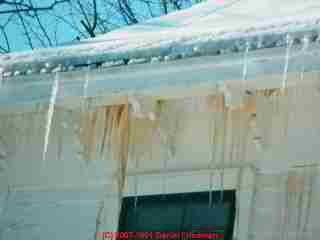
Attic Condensation and Ice Dam Leaks: If roof leaks or attic moisture condensation due to a combination of inadequate attic ventilation and a building moisture source (wet basement, plumbing leaks, roof leaks) causes excessive moisture or actual wet conditions in an attic, conditions are ripe for extensive mold growth.
Visible mold may appear on wood surfaces in an attic such as on rafters or roof sheathing.Hidden mold may be present and may be even more of a problem if it forms in insulation or in the ducts and air handler of an air conditioning or heating/air conditioning system.
Typical building air convection currents tend to move air up and out from lower to upper building levels, so one would not think that much mold would move down from an attic into the living area.
But important exceptions to this can quickly move problem mold from an attic into a living area. For more details on this topic see Attic Condensation & Ice Dams, Detection and Correcting Venting and Condensation Problems in buildings.
- Conditions moving mold downwards from an attic include the following:
- Mold growth in HVAC ducts or air handlers found in an attic
- Mold on any attic surface or in attic insulation if it is a species producing airborne spores and if the building uses a whole house ventilating fan, especially if there is inadequate exit venting for the fan operation. This condition pressurizes the attic and moves mold down through various openings into the floors below.
- Mold on building surfaces in an attic or attic knee wall space which opens onto or has a knee wall common with an upper floor living space such as a bedroom.
-
Building Exterior Leaks and Mold No mold cleanup project will be successful unless you correct the conditions that caused mold growth in the first place.
An expert inspection and report should find and suggest remedies for site and building exterior conditions that produce mold or for building areas that serve as a mold reservoir or as amplifiers for allergens, mold, mildew, excessive pollen or pet dander.
The basic steps: find all unwanted moisture sources, correct appropriate building, site, landscaping, & construction details.
90% of the wet basements and crawl spaces I see are caused by bad or missing roof gutters and downspouts.
An IAQ investigator who has training and experience in building science, mycology (mold science), and IAQ, or in some cases an experienced ASHI-Certified home inspector or sick building investigator who is who has a similar in-depth understanding of construction failures can be helpful at this step.
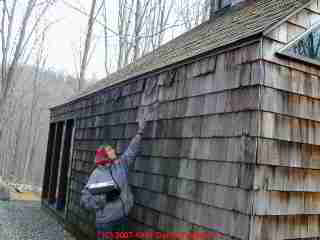
The photograph shows a double problem with this wood shingle exterior wall: shingles are improperly installed and falling off
of the home, inviting water to enter the wall structure.
Because there is no roof overhang or eaves, and not even a
gutter on the home, roof runoff runs right down this wall.
- Building Interior Leaks and Mold: address interior conditions that produce or serve as reservoir or amplifier for common allergens: mold, pollen, pet dander as well as other possible respiratory irritants such as latex, paints, product-outgassing furniture or carpets, and renovation hazards such as lead paint or chemicals or other environmental issues.
-
Plumbing leaks that are unattended, water running under kitchen or bathroom cabinets when fixtures are in use, and air conditioning system condensate leaks into the building or into the HVAC duct work are examples of indoor leaks that can lead to a mold problem if not promptly attended.
The photograph shows extensive staining from protracted plumbing leaks in a house that was left unattended. The result was extensive basement mold requiring demolition and cleaning of large area of the home.
- Indoor Humidity Control:
What indoor humidity should we maintain in order to avoid a mold problem?
A maximum indoor relative humidity of 55 should be OK, 50 better, 45 for an attic knee wall space which is not vented to outdoors. The moisture level you detect varies depending on when, where, and how you measure it.
For normal home use we like modern dehumidifiers such as this Sears ™ unit which permit setting a specific humidity level and also permit connecting the dehumidifier to a drain so that it can operate unattended. The article cited at the end of this paragraph explains the need for maintaining an anti-mold low humidity level in a building, sets moisture level targets, and tells you how to get the indoor moisture level into the desired range.
More detail about how to control indoor humidity is
at Indoor Humidity Control: - Improper placement of or damage to building vapor barriers, or insulation can cause not only mold contamination in the building (visible or hidden in building cavities, it can also cause substantial structural rot. See ROT, TIMBER FRAME for a case study.
- Mechanical Systems (Heating and Air Conditioning Systems) and Mold:
HVAC - Heating, Ventilation, Air Conditioning Systems and Duct Work Cleaning and Remediation Issues & Advice about mold are needed
from the same expert.
We often find that a building owner has paid for "duct cleaning" only to discover that simply opening the air handler unit (AHU) shows a filthy or moldy blower compartment!
Thoroughness is important as is the choice of duct replacement materials to reduce the chance of new mold growth and to make the system easier to clean.
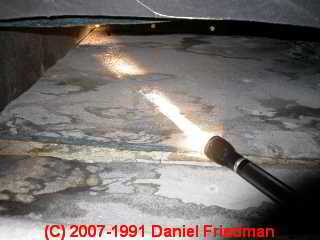
-
Duct Cleaning for mold or bacterial contamination: Leaks into duct work wet organic dust and
debris deposited on the duct interior, inviting mold growth.
Metal ducts and air handlers can often be cleaned.
Our experience is that fiberglass and fiberglass-lined ducts and air handlers cannot be cleaned effectively and worse, improper cleaning may cause dangerous release of fiberglass into the building air.
Don't just spray ducts with disinfectants and sanitizers.
The US EPA advises caution about using these chemicals, the AIHA also advises that occupants may suffer from respiratory irritation from these chemicals, and research on fungicidal treatment of fiberglass HVAC ducts suggests that their effectiveness is limited anyway.
The photo shows stains indicating a history of leaks into this fiberglass lined HVAC duct.
We recommended replacing the insulation, cleaning the duct interior (or replacing the duct work if that was less costly), and making sure that the leak source was repaired.
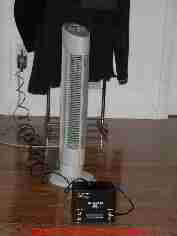
-
Indoor Air Cleaning Products can help improve indoor air
quality, but watch out for products that are ineffective.
At least one study has shown that there at least up to 2005 there was not one portable free-standing home "air cleaner" or "air purifier" on the market that moved enough cubic feet of air per minute to actually clean a home much less a room of problem airborne particles.
Portable air cleaners: The photo above shows a popular portable air cleaner in a room where we ran a time-lapse impaction sampler to collect particles at regular intervals to see what the machine seemed to be doing. We compared the particle levels in this room with the door shut, with the door open, and with other building areas.
OPINION: our clients' experience, confirmed by our own field testing suggest that in a room without severe dust and particle reservoirs (no pets, no wall to wall carpets), some air cleaners might reduce, but by no means eliminate, problematic airborne particles. The particle reservoir forms what is in a practical sense, an infinite particle source.
Central HVAC systems, with a much larger air handling capacity, can be equipped with filtration that can substantially reduce the level of indoor airborne particles. Their effectiveness can be increased still further if the system permits the fan and filtration to run continuously.
See details at AIR CLEANING PRODUCTS
- Fresh Air Ventilation / Air-to-Air Heat Exchange: contact local HVAC contractors and
see ALLERGY & IAQ PRODUCTS
...
Continue reading at FLOOD DAMAGE REPAIR PRIORITIES or select a topic from the closely-related articles below, or see the complete ARTICLE INDEX.
Or see these
Building Mold Contamination Prevention Articles
- MOLD CLEANUP GUIDE- HOW TO GET RID OF MOLD - home
- MOLD PREVENTION GUIDE - home
- FAILURE TO PREVENT FUTURE MOLD
- FLOOD DAMAGE REPAIR PRIORITIES
- FLOOD-CAUSED MOLD, PREVENTION
- FUNGICIDAL SEALANT USE GUIDE
- HUMIDITY CONTROL & TARGETS INDOORS
- IAQ or ANTI-MOLD PRODUCTS
- INADEQUATE REMEDIATION PLAN
- INEFFECTIVE MOLD PRODUCTS
- MOLD CLEANUP AREA CROSS CONTAMINATION
- MOLD PROOF DRYWALL
- MOLD RESISTANT CONSTRUCTION
Suggested citation for this web page
MOLD PREVENTION GUIDE at InspectApedia.com - online encyclopedia of building & environmental inspection, testing, diagnosis, repair, & problem prevention advice.
Or see this
INDEX to RELATED ARTICLES: ARTICLE INDEX to MOLD CONTAMINATION & REMEDIATION
Or use the SEARCH BOX found below to Ask a Question or Search InspectApedia
Ask a Question or Search InspectApedia
Questions & answers or comments about preventing toxic or other mold growth & contamination in buildings.
Try the search box just below, or if you prefer, post a question or comment in the Comments box below and we will respond promptly.
Search the InspectApedia website
Note: appearance of your Comment below may be delayed: if your comment contains an image, photograph, web link, or text that looks to the software as if it might be a web link, your posting will appear after it has been approved by a moderator. Apologies for the delay.
Only one image can be added per comment but you can post as many comments, and therefore images, as you like.
You will not receive a notification when a response to your question has been posted.
Please bookmark this page to make it easy for you to check back for our response.
IF above you see "Comment Form is loading comments..." then COMMENT BOX - countable.ca / bawkbox.com IS NOT WORKING.
In any case you are welcome to send an email directly to us at InspectApedia.com at editor@inspectApedia.com
We'll reply to you directly. Please help us help you by noting, in your email, the URL of the InspectApedia page where you wanted to comment.
Citations & References
In addition to any citations in the article above, a full list is available on request.
- Disease Prevention in Home Vegetable Gardens [PDF], Patricia Donald,Department of Plant Microbiology and Pathology,
Lewis Jett
Department of Horticulture, University of Missouri Extension - extension.missouri.edu/publications/DisplayPub.aspx?P=G6202 - "Management of Powdery Mildew, Leveillula taurica, in Greenhouse Peppers," Ministry of Agriculture and Lands, British Columbia - Original source: www.agf.gov.bc.ca/cropprot/peppermildew.htm
- In addition to citations & references found in this article, see the research citations given at the end of the related articles found at our suggested
CONTINUE READING or RECOMMENDED ARTICLES.
- Carson, Dunlop & Associates Ltd., 120 Carlton Street Suite 407, Toronto ON M5A 4K2. Tel: (416) 964-9415 1-800-268-7070 Email: info@carsondunlop.com. Alan Carson is a past president of ASHI, the American Society of Home Inspectors.
Thanks to Alan Carson and Bob Dunlop, for permission for InspectAPedia to use text excerpts from The HOME REFERENCE BOOK - the Encyclopedia of Homes and to use illustrations from The ILLUSTRATED HOME .
Carson Dunlop Associates provides extensive home inspection education and report writing material. In gratitude we provide links to tsome Carson Dunlop Associates products and services.


